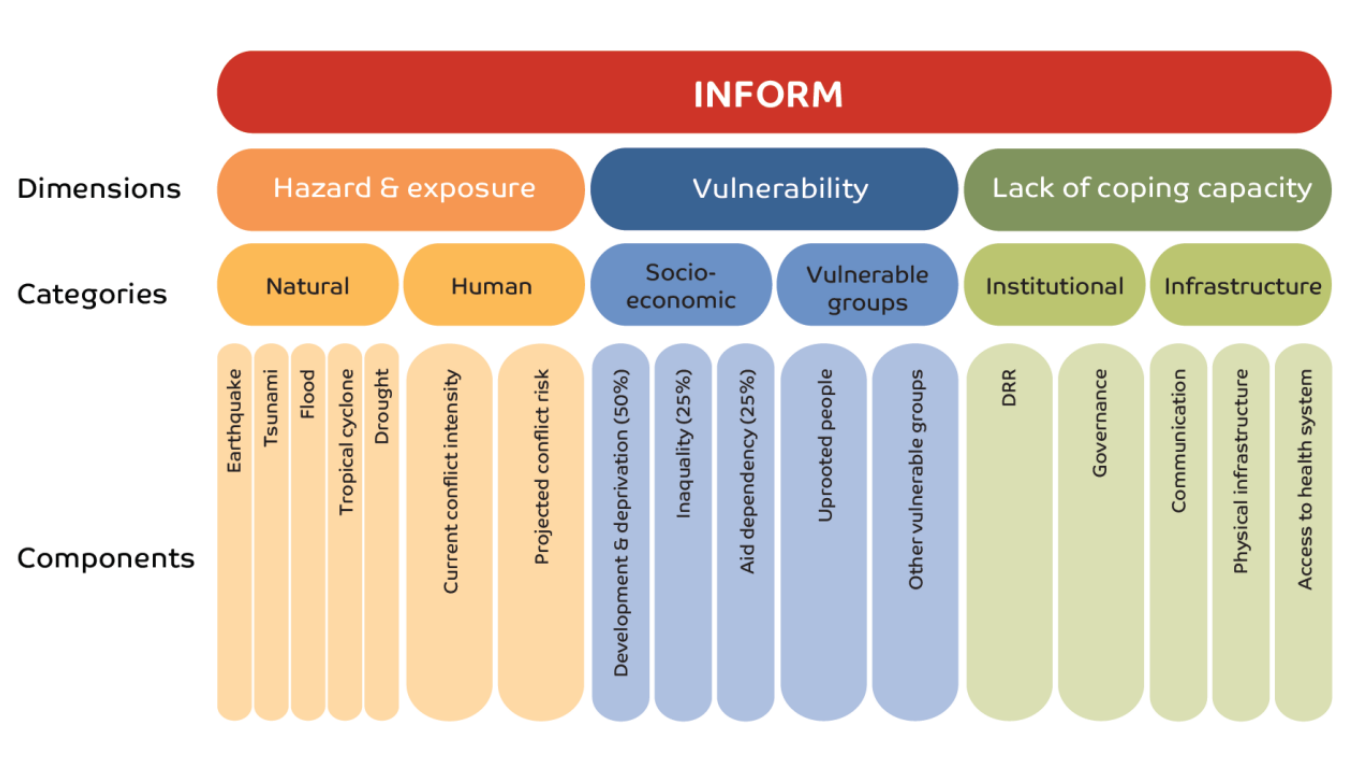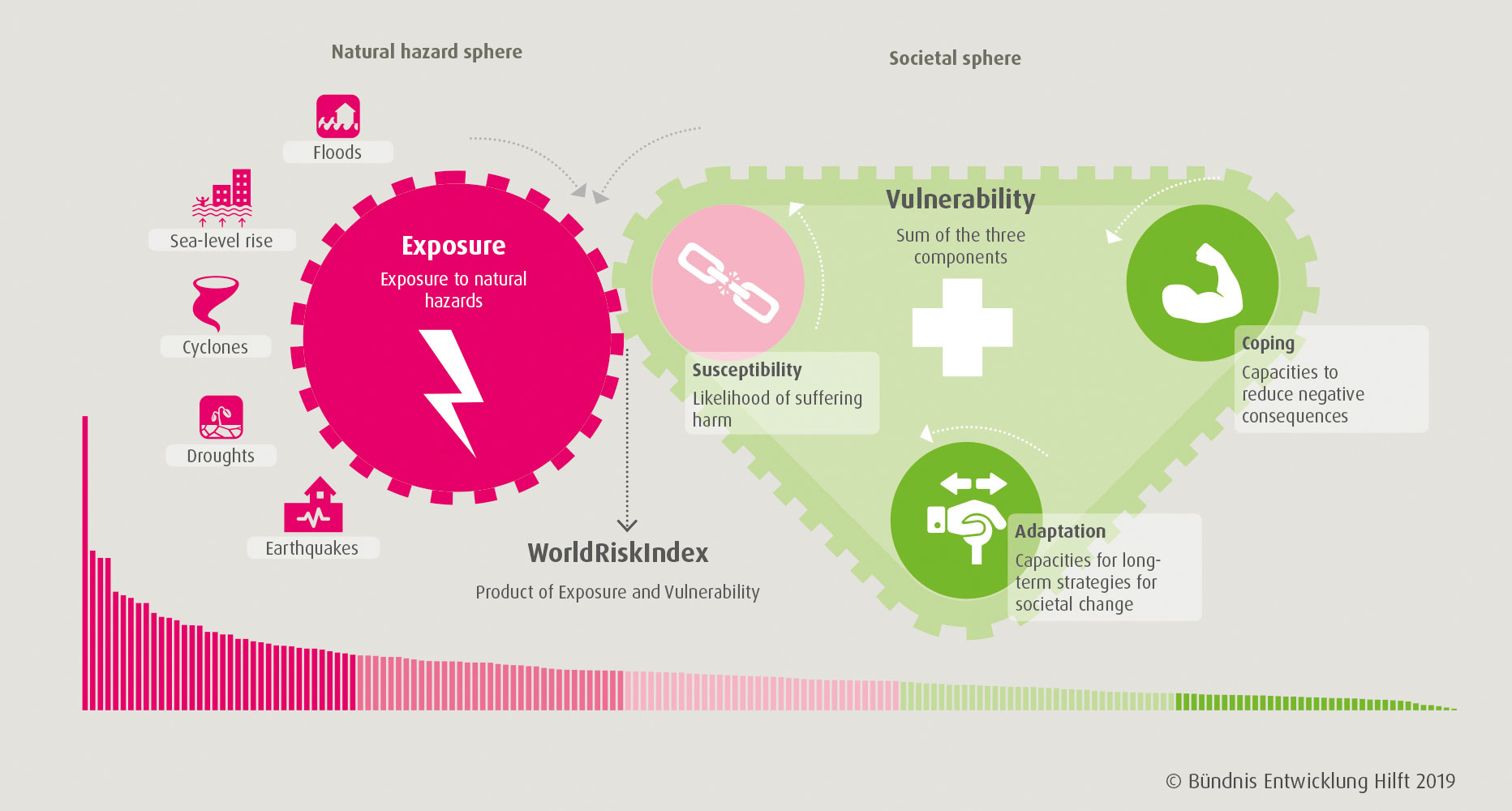
It is very important to have data on hazard, exposure, vulnerability and losses in order to understand and assess disaster risk.
Computational risk modelling allows to couple exposure data with vulnerability and hazard models to generate deterministic and probabilistic risk estimates. The modelling of synthetic events is a way of compensating for the limited available historical information, particularly in the case of extreme events related to intensive risk.
Explore the following indexes:
InfoRM and GRI
InfoRM is a way to measure the risk of humanitarian crises and how the conditions that lead to them affect sustainable development. It is a risk index that identifies where crises requiring international assistance may occur and analyses that risk so it can be better managed by everyone.
The InfoRM initiative began in 2012. It has evolved from a publisher of a risk index to a forum for shared analysis, and currently (2019) calculates the recent GRI (INFORM Global Risk Index) that uses 50 different indicators to measure hazards and peoples’ exposure to them, vulnerability, and the resources available to help people cope, or in other words: Hazards & Exposure, Vulnerability and Lack of Coping Capacity.
GRI creates a risk profile for 191 countries (including all the SADC countries) that includes both natural and human hazards. Each has a rating between 0 and 10 for risk and all of its components, so it’s easy to compare. All the individual indicators, index components and calculations are open and transparent.
Inform GRI is, therefore, a composite Index For Risk Management identifying countries at risk from humanitarian emergencies and disasters that could overwhelm current national response capacity, and therefore lead to a need for international assistance.

WRI
The World Risk Index (WRI) indicates the disaster risk for countries, meaning: the general risk of countries falling victim to a disaster caused by extreme natural events (e.g. cyclones, floods, droughts or sea-level rise).
The WRI is based on a model which also operationalizes the ability of a society to react to such events, considering that social factors, political conditions and economic structures are also responsible for whether a disaster occurs in connection with extreme natural event. This assumes that every society can take direct or indirect precautions to reduce the effects of natural hazards.
The WRI considers natural events and social factors and hence, it computes two dimensions of risk: exposure (which refers to natural hazards, such as floods, sea-level rise, droughts, cyclones) and vulnerability, integrating three aspects – susceptibility (likelihood of suffering harm); coping capacities (depending on governance, healthcare, social and material security); and adaptive capacities (related to coming natural events, climate change, and other challenges).
The concept of the WRI was developed together with the United Nations University’s Institute for Environment and Human Security (UNU-EHS). Since 2018, the Index is calculated by the Institute for International Law of Peace and Armed Conflict (IFHV) of Ruhr-University Bochum. It uses a total of 27 indicators, which are available in publicly accessible data sets.
The most recent assessment (World Risk Report 2019) presents the WRI for 180 countries, including all the SADC States.

HDI
The Human Development Index (HDI) is a summary measure of average achievement in key dimensions of human development: a long and healthy life, being knowledgeable and having a decent standard of living.
The HDI simplifies and captures only part of what human development entails, not reflecting on inequalities, poverty, human security, empowerment, etc.
The HDI 2018 for 189 countries has been calculated in the Human Development Report 2019, including all the SADC Member States.

Related links:
- INFORM GRI 2020, containing the most recent calculations and basic documents: https://drmkc.jrc.ec.europa.eu/inform-index
- WRI official website, containing the recent 2019 report and other useful info: https://weltrisikobericht.de/english-2/
- UN Human Development Reports: http://www.hdr.undp.org/
Related documents:
- Inform report (2019), containing an overview of InfoRM and of the recent GRI (Global Risk Index)
- Index for risk management, InfoRM: Concept and Methodology (2015)
- InfoRM FAQ, containing frequently asked questions about InfoRM
- World Risk Report (2019)
- Human Development Report (2019)